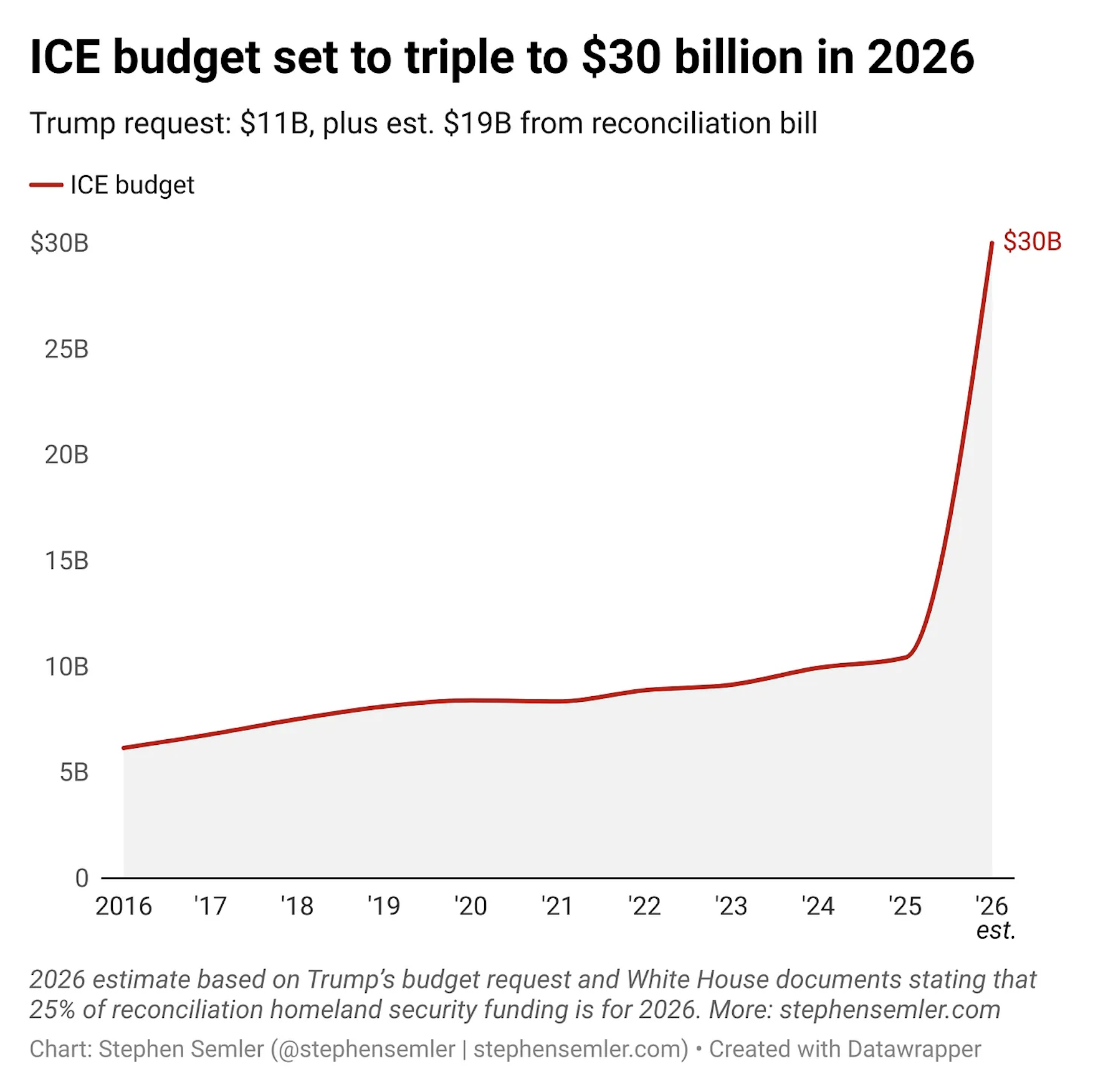Immigration and Customs Enforcement (ICE) deported 545,252 people from the US between 2021 and 2024, according to its data, including 271,484 last year.
The Trump administration wants to deport one million people per year. To that end, there’s $75 billion for ICE in the One Big Beautiful Bill Act, which was signed into law earlier this month. This includes:
- $45 billion to expand the agency’s “detention capacity,” including building new ICE prisons (see Section 90003 of the bill).
- $30 billion for bonus pay for ICE personnel; recruiting, hiring, and training new personnel; additional facilities, vehicles, and funding for “enforcement and removal operations” (see Section 100052).
The actual total is likely higher than $75 billion. While that’s the amount specifically designated for ICE in the legislative text, there are sections of the reconciliation bill that allow the Trump administration to direct billions more to the agency if it wants to. These sections effectively form a slush fund for Department of Homeland Security (DHS) leadership. Here are two examples that immediately come to mind:
- Section 100051 provides $2.1 billion to DHS, the cabinet department that houses ICE. While this section doesn’t explicitly say any of the funding is for ICE, of its twelve listed purposes, four involve removals, which ICE manages.
- Section 90007 provides $10 billion to DHS for “undertaking activities in support of the Department of Homeland Security’s mission to safeguard the border of the United States.”
That second one basically says nothing and is the extent of the details — and guardrails — for the $10 billion provision. I’m not kidding; here’s the entire section:
With this $75 billion in extra funding, the Trump administration expects ICE to swell its ranks by 50 percent, expand its detention capacity by 100 percent, and increase removals by 268 percent by 2029.
The aforementioned funding in the reconciliation bill adds to — not replaces — the amount ICE receives through the regularly scheduled federal budget process. Congress approved $10.4 billion for the agency through this process in 2025, and Trump requested $11.3 billion for 2026.
The Big Beautiful Bill allows ICE to use this extra $75 billion anytime between now and the end of September 2029 (i.e., during fiscal years 2025–29). Technically, all $75 billion counts toward 2025’s total — for budget enforcement and scorekeeping purposes, funding made available over multiple years generally counts toward the first year agencies can start using those funds, which in this case is 2025.
I chose not to construct the chart below that way because it’s too far removed from how the money will realistically be spent. Donald Trump signed his bill with less than three months left in fiscal year 2025, and White House budget documents show it would only begin using the extra funding next (fiscal) year. Those documents also indicate that DHS will obligate 25 percent of the homeland security funds in the reconciliation bill next year. To estimate the 2026 ICE budget, I assumed the 25 percent share would apply equally on a pro rata basis across all DHS agencies, including ICE. That $18.7 billion was added to the $11.3 billion requested in Trump’s 2026 funding request.
The graph below shows that ICE’s budget is projected to triple next year to $30 billion, which is more than Poland spent on its military last year. Compared to the world’s largest military budgets, ICE’s 2026 budget would rank in the top fifteen.
The $30 billion estimate for 2026 is the most responsible one I could make given the available evidence. I also think it could end up being too low, possibly by a lot. There are likely billions more for ICE in the reconciliation bill than the $75 billion officially designated as such in the bill text, due to the nebulous DHS slush fund I mentioned earlier.
Additionally, the White House budget documents I referred to indicated that “at least” a quarter of the extra funding would be spent in 2026. I suspect the Trump administration will front-load the $75 billion rather than evenly distribute it each year from 2026 to 2029, thereby driving next year’s ICE budget above $30 billion. What I’m getting at is that despite my estimate being methodologically sound, this chart could age like it drank from the wrong grail. The projected $30 billion for 2026 visualized below should be considered a minimum estimate.

The Trump administration wants to increase yearly deportations by 268 percent, and ICE’s forthcoming $30 billion budget is the first major expenditure in pursuit of that quota.
To meet that aggressive (and arbitrary) goal, recent history shows that ICE will likely seek to inflate its removal numbers by targeting noncitizens with no criminal history, including those who are legally in the country or are in the process of legalizing their status.
Annual deportations surged 360 percent under the Biden administration. From 2021 to 2024, the number of people deported who had been convicted of a crime increased by 74 percent. By comparison, deportations of people with neither a criminal record nor pending charges jumped nearly 1,200 percent. More than two out of every three people ICE deported last year fit the latter description. All this is according to ICE’s own data.
ICE has already made this approach clear by systematically arresting people applying for citizenship at their immigration appointments, regardless of their legal status. Predictably, Palestinian activists have been targeted.
It’s already clear who ICE won’t target.
ICE has a “Human Rights Violators and War Crimes” page, where it claims to be “at the forefront of the U.S. government’s efforts to prevent the United States from becoming a safe haven for individuals who commit war crimes, genocide, torture and other forms of serious human rights abuses around the globe.” ICE’s stated goals are to “prevent the admission of known or suspected war criminals . . . into the United States,” “prosecute individuals in the United States who have been involved in and/or responsible for . . . human rights violations across the globe,” and “remove offenders” from the country.
Israeli prime minister and International Criminal Court fugitive Benjamin Netanyahu visited the United States earlier this month. Where was ICE when Netanyahu was galavanting around Capitol Hill?
Great Job Stephen Semler & the Team @ Jacobin Source link for sharing this story.





